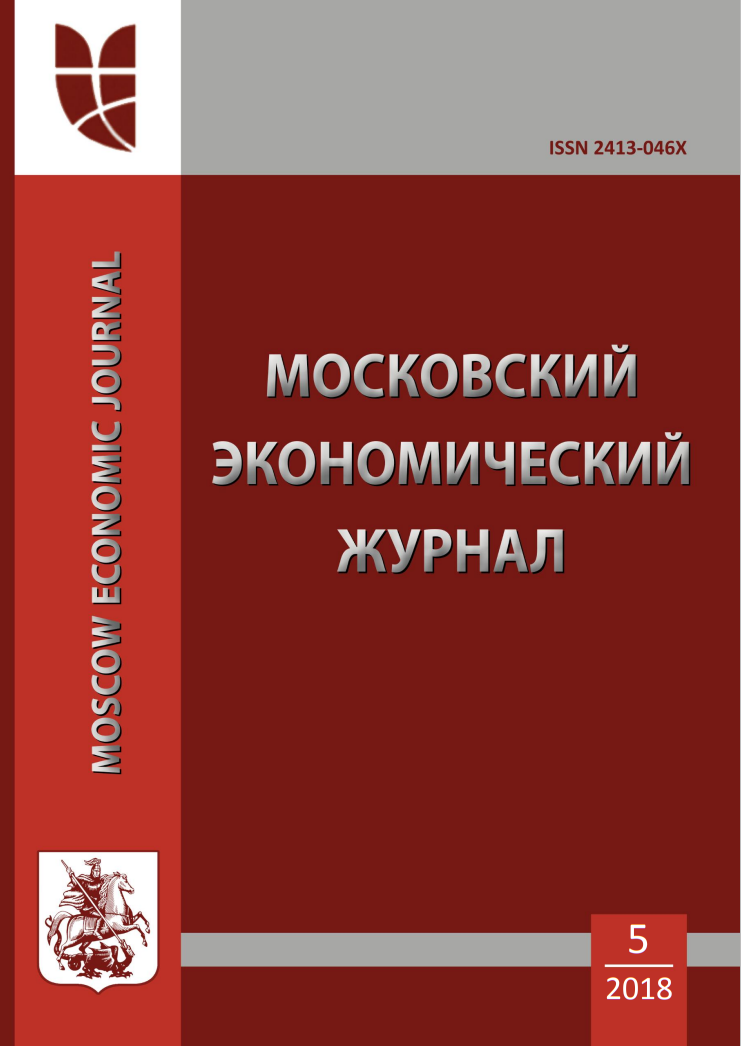Russian Federation
Russian Federation
The article focuses on economic operators with fuzzy properties. Based on some fuzzy market evaluations, the excess demand function is analyzed. A modification of the Walrasian dynamic model of a single commodity market is presented. Based on this and the predefined clear model, interval estimations of the equilibrium point for the model in question are derived. For the equilibrium point, the conditions of its stability are determined. They are represented as a system of inequalities for the model's parameters. Additionally, the equality is proved between the solvability of some boundary value problem and the classic Walrasian dynamic model of a single commodity market. In the latter, supply price adjustment coefficients are considered constant for constants, while demand price is derived with the piecewise constant lag of supply price taken into consideration. An approximate solution to the aforementioned boundary value problem is presented. The results concerning the equality between the boundary value problem and the market model are applied to the modified interval model. The problem of the w-fold change in commodity price by the specified moment is formulated and solved.
single commodity market, equilibrium point, demand function, boundary value problem, interval estimations
1. Azbelev N.V., Maksimov V.P., Rahmatullina L.V. Vvedenie v teoriyu funkcional'no-differencial'nyh uravneniy. - M.:Nauka, 1973. - 384 s.
2. Maksimov V.P., Rumyancev A.N. Kraevye zadachi i zadachi impul'snogo upravleniya v ekonomicheskoy dinamike. Konstruktivnoe issledovanie// Izvestiya Vuzov. Matematika, 1993, №5. -S. 56-71
3. Suslov V.I. Ob ekonomicheskih izmereniyah: veroyatnost' i dostovernost', matematicheskoe modelirovanie, bol'shie dannye, elektronnaya statistika// Voprosy statistiki, 2016, №1(4). - S.38-46
4. Nikaydo H. Vypuklye struktury i matematicheskaya ekonomika. - M.: Mir, 1972. - 519 s.
5. Goodwin R.M. Dynamical coupling with especial reference to markets having production lags// «Econometrica», 1947, №15. - S.181-204
6. Allen R. Matematicheskaya ekonomiya. - M.: Inostrannaya literatura, 1963. - 670 s.
7. Kalman R., Falb P., Arbib M. Ocherki po matematicheskoy teorii sistem. - M.: Mir, 1971. - 400 s.
8. Zadeh L.A. Fuzzy Sets// «Inf. And Control», 1965, № 8. - S. 338-353
9. Wong C.K. Fuzzy Topology. Fuzzy Sets and their Applications to Cognitive and Decision Processes. - New York: Academic Press, 1975. - 507 p.
10. Zadeh L.A.: The concept of a linguistic variable and its application to approximate reasoning// Inf. Sci., 1975, Part I, № 8. - S. 199-249; Part II, №8. - S., 301-357; Part III, №9. - S.43-80
11. Gusev Yu.M., Efanov V.N., Krymskiy V.G., Rutkovskiy V.Yu. Analiz i sintez lineynyh interval'nyh dinamicheskih sistem (sostoyanie problemy)// Izvestiya AN. Tehnicheskaya kibernetika, 1991, №1. - S. 3-23; № 2. - S. 3-30
12. Aschepkov L.T., Davydov D.V. Stabilizaciya nablyudaemoy lineynoy sistemy upravleniya s postoyannymi interval'nymi koefficientami// Izvestiya vuzov. Matematika, 2002, №2. - S. 11-17
13. Aschepkov L.T., Kolpakova G.E., Stegostenko Yu.B. Stabilizaciya nestacionarnoy lineynoy diskretnoy sistemy upravleniya s interval'nymi koefficientami po nablyudeniyam fazovyh sostoyaniy//»Avtomatika i telemehanika», 2002, № 5. - S. 3-11
14. Davydov D.V. Lokal'naya stabilizaciya interval'no nablyudaemoy sistemy s neopredelennymi parametrami//»Vychislitel'nye tehnologii», 2003, №1(8). - S. 44-51
15. Aschepkov L.T., Kosogorova I.B. Minimizaciya kvadratichnoy funkcii s interval'nymi koefficientami// Zhurnal vychislitel'noy matematiki i matematicheskoy fiziki, 2002, №5(42). - S. 653-664
16. Levin V.I. Sravnenie interval'nyh velichin i optimizaciya neopredelennyh sistem//» Informacionnye tehnologii», 1998, №7. - S. 22-32
17. Aschepkov L.T., Gutorova S.V., Karpachev A.A., Li S. Interval'nye matrichnye igry// Dal'nevostochnyy matematicheskiy zhurnal, 2003, №2. - S. 276-288
18. Shashihin V.N. Reshenie interval'noy matrichnoy igry v smeshannyh strategiyah// Izvestiya RAN. Teoriya i sistemy upravleniya, 2001, №5. - S. 97-104
19. Buckley J.J. The fuzzy mathematics of finance// Fuzzy Sets and Systems, 1987, Vol. 21. - S.257-273
20. Kofman A., Hil Aluha X. Vvedenie teorii nechetkih mnozhestv v upravlenii predpriyatiyami. - Minsk: Vyssh. Shkola, 1992. - 224 s.
21. Kuchta, D. Fuzzy capital budgeting// «Fuzzy Setsand Systems», 2000, Vol. 111. - S. 367-385
22. Lefley, F., Sarkis, J. Applying the FAP model to the evaluation of strategic information technology projects// International Journal of Enterprise Information Systems, 2005, №1. - S. 69-90
23. Huang X. Optimal project selection with random fuzzy parameters// Int. J. Production Economics, 2007, Vol. 106. - S. 513-522
24. Nedosekin A.O. Nechetko-mnozhestvennyy analiz riska fondovyh investiciy. - M.: Sezam, 2002. - 181 s.
25. Simonov P.M. Issledovanie ustoychivosti resheniy nekotoryh dinamicheskih modeley mikro- i makroekonomiki// Vestnik Permskogo un-ta. Matematika. Informatika. Mehanika, 2003, №1. - S. 88-93.











